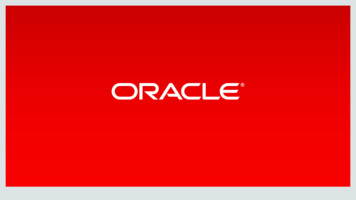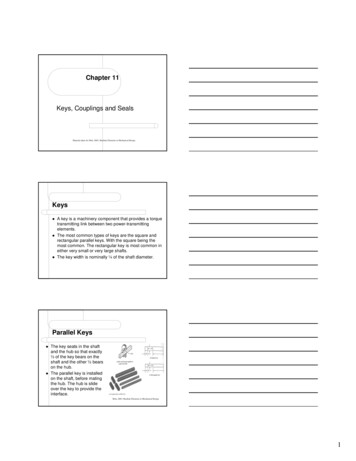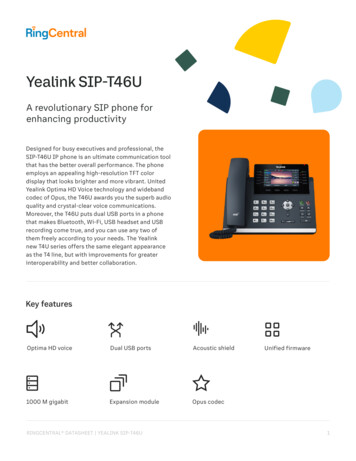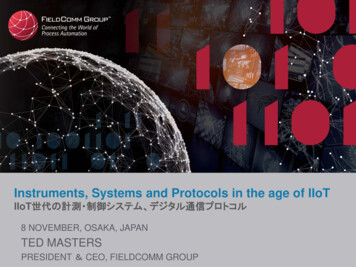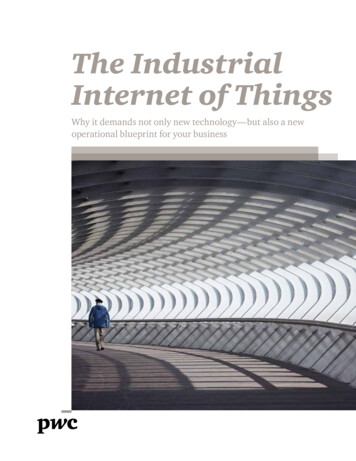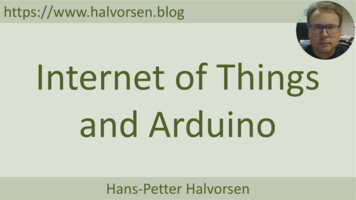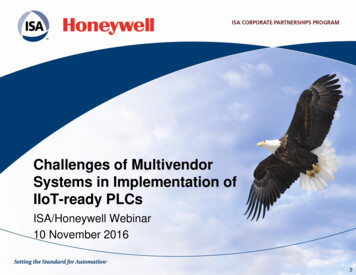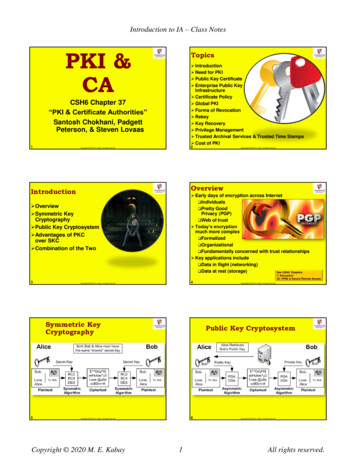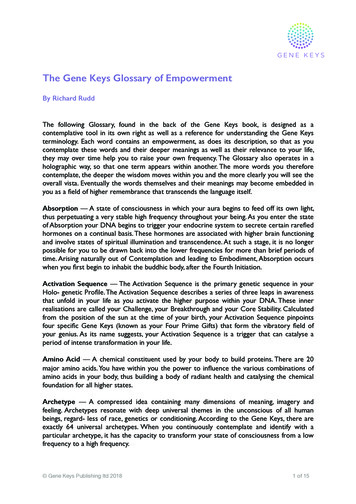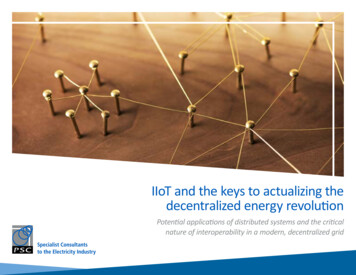
Transcription
IIoT and the keys to actualizing thedecentralized energy revolutionPotential applications of distributed systems and the criticalnature of interoperability in a modern, decentralized grid
Table of contentsIntroduction. . . . . . . . . . . . . . . . . . . . . . . . . . . . . . . . . . . . . . . . . . . . . . . 2Grid edge and distributed systems . . . . . . . . . . . . . . . . . . . . . . . . . . . . 3Real world applications of a distributed system. . . . . . . . . . . . . . . . . . 5Interoperability in a decentralized grid. . . . . . . . . . . . . . . . . . . . . . . . . 8Conclusion. . . . . . . . . . . . . . . . . . . . . . . . . . . . . . . . . . . . . . . . . . . . . . . 12About the authorJohn CamilleriJohn Camilleri is a Principal Architect withPSC in North America. Over the last 25years, he’s had in-depth experiences inthe evolution of renewables, distributedgeneration, microgrids and developingreal-time systems to manage them. Johnhas a Master of Science degree in Electrical Engineering and enjoys developing andleveraging new technologies to optimizethe electrical grid.1
IntroductionInnovations in power generation,storage, and transmissiontechnologies are forcing a shiftaway from centralized powergeneration towards a distributed,decentralized model.Utility operations are presented withnew challenges related to security andcontrols; how they respond will shape thefuture of the decentralized energy landscape. This eBook investigates the potential applications of distributed systems,as well as the role of interoperability inactualizing the decentralized energy revolution.Growing penetration of renewable devices and inverter-based controls aredriving a need for intelligence at thegrid edge. Active management will berequired to fully leverage the distributedpower technology of the future, with increased telemetry data and low latencycoordination between devices, enablingbi-directional power flow.
Grid edge anddistributed systemsApps at the edgeThe grid edge refers to the electrical distribution network down to devices in thefield and represents a wide array of technologies and operational requirements.Today, the edge includes a growing number of software applications supportingvarious functions – think of mobile appsfor the power grid, and you will see weare on the precipice of a revolution.Intelligence at the edge spans the range ofsimple to complex functions that can optimize and analyze data and perform command and control. This is the role of the app.With the deployment of more advanceddevices such as battery managementsystems, controllable loads, and non-dispatchable generation, coordination andoptimization of these resources in thefield are critical to achieving the balanceof analytics in a centralized operationcenter vs. real-time telemetry and control in the field.Advantages and challengesof decentralizationWith a centralized solution, the volumeof data being collected produces latencies that are not conducive for implementing certain levels of control andoperation in the field. Security in centralized systems may be more familiar,but it does not necessarily offer moresecurity than a distributed system. Datain motion, from the field, still needs to besecured. The endpoint, where the data iscollected, is typically a difficult-to-secureIT device in a centralized deploymentscheme. Access control for such endpoints is typically generalized for a teamto work on without specific identitiesbeing enforced. Endpoint devices haverudimentary authorization models – ifthey exist at all.Forcing a distributed approach is an opportunity to drive better security controls and conform to modern best practices for both cyber and physical security.Clearly, there are security controls andprocesses that can and should be implemented. In general, the utility operationsIT environment is running on borrowed3
time regarding cybersecurity measures inthe field.Distributed systems come with a host ofchallenges. The sheer number of instances increases the administrative requirements for deployments and updates. Securing these distributed services requiresa systematic approach. The drive fordistributed systems pushes the level ofinteroperability between systems, plugand integrate approaches, and rethinkingthe application space.A modern grid recognizesall stakeholdersAlthough distributed systems presenttheir own challenges, there is an opportunity to leverage modern software deployment and management approachesto create a significant advancement thatwill enable the general public to be partof the decentralized energy revolution.Kickstarting the market by articulatingbusiness value and finding the right nexus of industry players is the key businesschallenge.4
Real world applications of a distributed systemDistributed power system applicationsDistributed systems in the energy space can be applied to serve many objectives.The following list provides some potential applications. Transactive energy: Requiresmachine-to-machine interactionbetween two business entities toexecute a transaction. Better use of capital assets: In-fieldoptimization of assets for better performance and utilization or simplyenabling fine-grain control. Microgrids: Opportunity to providein-field analytics and distributedcontrol functions. Multi-vendor solutions: Create aninteroperability nexus by allowingmulti-vendor solutions. Renewables: Support the data collection of customer side renewabledeployments that support utilityoperational insight. Enabling competition: Innovation byallowing open access to data and theability to tackle smaller-scoped problems. On-premises energy managementsolutions: Support optimal controlof on-premises energy resourcesand loads based on global controldirectives Predictive maintenance: AI appliedin the field to detect anomalies andreport backIt is important to note that with a distributed system approach, incrementalrollouts reduce complexity and cost. Even more important is the ability to stackthe benefits once you have the interoperability platform in place.
IIoT considerations fora distributed approachIndustrial Internet of Things (IIoT) platforms are becoming available to achievesome of these goals. As with any systemdesign, evaluating the requirements iscomplicated and worth the investmentif you tie those requirements to testingand verifiable customer needs. Whenconsidering these types of platforms,you should consider this as evolvingtechnology so future requirements tendto be fuzzy. This may lead you to one ofthe key design principles, “minimal functionality,” to ensure the solution is notover-engineered.The above application of IIoT deservessome consideration. Various architectures can be applied to each applicationarea. With distributed architectures, youneed to consider several things at first:1. Workload: Where do you want thecompute power to be and why?2. Communications: What are the latency and bandwidth requirements?3. Management: How will you managethe distributed devices remotely?“When considering thesetypes of platforms, youshould consider this asevolving technology sofuture requirements tendto be fuzzy.”4. Security: What security vulnerabilitiesdoes the system have and what is thethreat model?6
Hypothetical IIoT architectureThe following notional architecturedemonstrates a distributed approach fortransactive energy.In this diagram, residential homes havetheir own DER and Load. A DistributedProcessing Node (DPN) that may be integrated into a smart meter provides monitoring (and control) of each resource andcommunicates on the message bus forpricing signals to ramp up or ramp down.The DPN acts as a mini-control aggregator. The price signals submitted by otherresidential or commercial DPNs in thelocation, including devices like community energy storage, residential communitysolar or charging stations are consumedby each peer.Once the infrastructure for communication and processing is in place, the logicperforming business rules can be updated over-the-air like your cell phone.Layered applications can then be distributed to support other functions as needed to meet the customer requirements.Landis Gyr’s developer studio is oneexample of this approach.Notional Architecture for Transactive EnergyLoadDERMetering Interface (MI)Message Bus (MB)Distributed ProcessingNode (DPN)7
Interoperability ina decentralized gridInteroperability will bringus closer to the grid edgeThe current power industry vendor landscape evolved to provide vertically integrated utility solutions. There is a needfor some siloing around the purchasingof physical assets due to procurementand risk management issues. The recentExecutive Order on US Bulk-Power System highlights another risk that utilitiesmust manage while still striving for interoperability. The obvious challenge isthat when a utility chooses a hardwarevendor for field devices all the way downto the communication layer, they have tobe mindful of the software interoperability and manageability over time sincehardware and software have differentlifecycles.Software in the electric utility industryhas not traditionally provided open,unfettered access to data. But ultimately,accessing the data and acting upon it ina timely manner is paramount to beingable to innovate and provide new solutions at the grid’s edge.Economic driversIn the commercial space, economic drivers push solutions to reduce cost and provide more benefit. The emergence of IIoTin the medical and vehicle solution spaceis moving fast, driven by single-vendorholistic solutions. Interoperability can belimited, considering these solutions areinitially being driven by those who ownor manufacture assets and the softwarethat controls them. Standardization is acommon approach to harmonizing solutions. As a technological society, we havelearned some lessons around interoperability and the economic value it can provide. Entire markets are now supportedby platforms-as-a-service like Microsoft’sAzure IoT or Amazon’s AWS IoT solutions.These vendors may push their own special sauce but work behind the scenesto develop industry standards that willenable the upper levels of the applicationstack to work seamlessly across varioushardware platforms.8
Interoperability standardizationStandards in the power industry have attempted to provide system, syntactic andstructural level interoperability. Many ofthe common protocols such as Modbus,IEEE 1815 (DNP3), or IEC 61850 go a longway to provide interoperability betweena control system and the field device,which was the original intent. IEC 61850was a vast improvement over Modbusand DNP3 regarding the definition of acommon model and has been widelyaccepted for use in Europe and othercountries outside the US for substationautomation. IEC 61970 (CIM) providesa power system model for equipmentand energy data. These are all importantsteps for interoperability. Efforts to addenhancements and address specifics ofrenewables and security are ongoing.There are new initiatives in the electrical industry such as the North American Electric Standards Board (NAESB)RMQ.26 Open Field Message Bus (OpenFMB (https://openfmb.ucaiug.org/) standard. Supporters of this standard arelooking to push interoperability betweensystems through a common data model and business processes intended todevelop vendor-neutral communicationbased on publish/subscribe technologies.Moving data from the endpoint deviceinto OpenFMB is currently the focusof groups like UCA International UserGroup. Supporters of OpenFMB attemptto take the efforts from the previousstandards in defining a common modelto drive a simpler model of operationaldata exchange between systems. Theytarget a distributed approach, whereappropriate, with the goal of supportinginteroperability between multi-vendorsystems in the field.Standardization of these schemas is thereal challenge and may be swapped witha de-facto standard schema that theindustry or large companies push. Consider the case of word processing, wherethe de-facto binary format of text documents is Microsoft’s DOC format. Sincestandards bodies typically move slow,this may not be a bad resolution – as itplaces the burden of managing the schema versioning onto stronger distributedsoftware platforms9
Vendor flexibilityThere is clearly a balance between openstandards that support interoperabilitybetween vendors, and proprietary systems. Competition and necessity eventually push the needle in these areas. Asan example, consider two distributedplatforms deployed into an electric distribution system. In figure 1, deploymentalpha illustrates a highly proprietarystack while deployment zeta illustrates ahighly modular stack leveraging interoperability between vendor systems encompassing both hardware and software.There are a number of solutions availablein the market today around intelligentswitching, voltage conservation, andothers. Of course, there are exceptionsto how much of the stack these vendorsolutions own – but each solution hassignificant control over how the layersinteroperate. This may provide a solutionthat is more cost-effective or customizable for the customer in the near term.As soon as you start to decompose thelayers the need for industry standardsand interoperability between vendorsbecomes a hard requirement. For example, if you want multiple applicationsDeployment AlphaDeployment ZetaApplicationsMessaging SchemaMessaging ProtocolsField Device I/O(Relays, IEDs, etc.)BackboneCommunicationsIncreasing Interoperability Between Vendors/Hardware/Softwareto run at the top of the stack, and youwant to use different vendors for thoseapplications, field devices, and communication backbone components, theninteroperability is imperative.To put this into perspective, considerthat communication and physical devices in the field demand a very large andlong-term capital investment. The abilityto leverage these layers for multiple usecases becomes a critical economic factorin the planning of large CapEx projects.Another consideration is the ability tolocalize a solution. In other words, youmay want to focus on various voltagemanagement solutions at one group ofsubstations and support other powerquality-monitoring and control functionsat another group of substations. Theapplications may be from different vendors driving best-in-class solutions andall leveraging the underlying communication and field devices from one or morevendors. Clearly, this lowers the procurement risks associated with a single vendor, increases competition, and drivesnew solutions.10
Semantic interoperabilityTwo types of interoperability are syntactic and semantic. Syntactic interoperability is where two systems can exchange acommon data format. But, for example,if a control system talks to an energystorage system (ESS), the systems areunable to determine how each otherfunctions or how to interact togetherfrom the data model. The context of theESS is built up by humans. Syntactic interoperability allows systems to integrate.Semantic interoperability allows thecontrol system to identify the communicating device as an ESS and detectwhat functions it can perform. A keyrequirement of distributed systems is theability for the machines to have semantic interoperability, allowing distributedfunctions to react to new devices andcapabilities without direct human intervention. Otherwise, these distributedsystems become very brittle due to thehuman management process required tointegrate.“Semantic interoperability allows the control systemto identify the communicating device as an ESSand detect what functions it can perform.”11
ConclusionIn summary, technology is notan impediment to energy IIoTsolutions.As end consumers gain visibility andestablish a voice in defining the potentialvalue of the distributed intelligence approach, progress will occur driven by trueeconomic pressure. The diversity and prevalence of interoperating components isincreasing on the grid edge. The ability toshare and fully utilize data between components is necessary for their intelligentmanagement. Advancing interoperabilityand open interoperable standards willhelp systems work smarter and more efficiently and ensure that today’s technologycan interface with future technologies.
pscconsulting.com15 locations. One worldwide partner. 2020 PSC Specialists Group, Inc. All Rights Reserved. EB-OT-IIoT-and-the-KeysAt PSC, we’re helping power a moresustainable world. Our global team ofelectricity experts has been tackling thethorniest problems for some of the mostprominent industry players for over 25years. By empowering people to make adifference and do the right thing, we helpour clients and employees innovate andthrive in a rapidly changing industry.
the common protocols such as Modbus, IEEE 1815 (DNP3), or IEC 61850 go a long way to provide interoperability between a control system and the field device, which was the original intent. IEC 61850 was a vast improvement over Modbus and DNP3 regarding the definition of a common model and has been widely accepted for use in Europe and other



